Decarbonizing Agriculture
Part 1: Understanding Emissions Sources
By Patrick Pelegri-O’Day
November 9, 2023
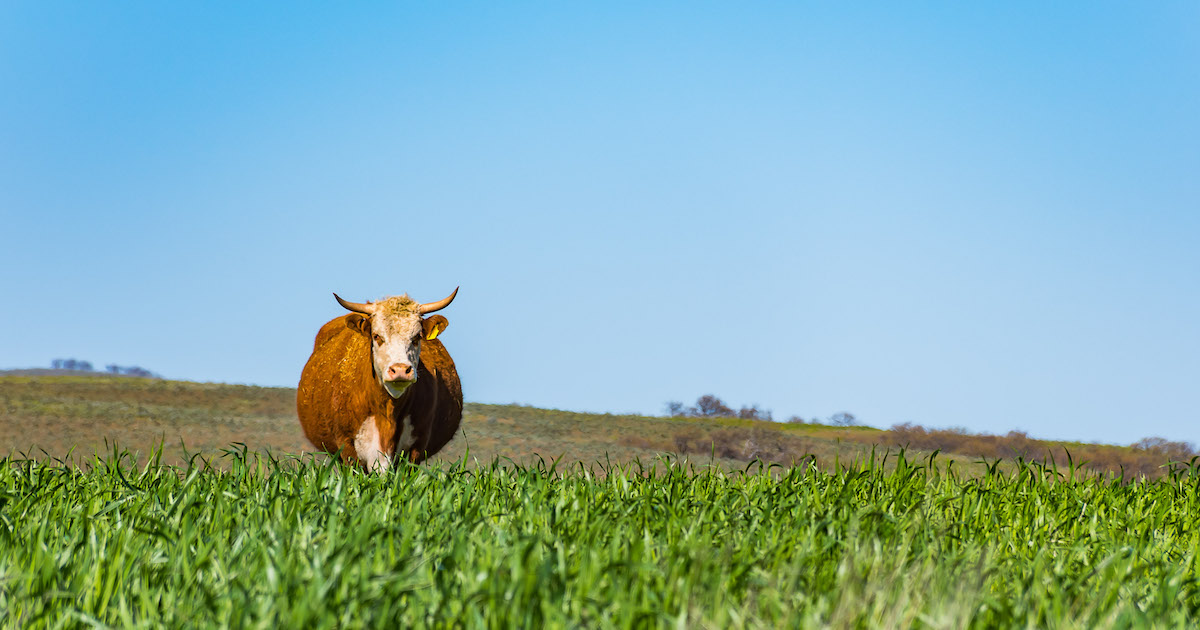
Introduction
The food sector is a huge source of global greenhouse gas (GHG) emissions. The statistics are striking, and while exact percentage varies between studies, one common estimate is that about a third of global emissions originate from activities in the food system (Searchinger et al. 2021). Even in the United States, where the percentage is comparatively lower, the impact is still substantial. According to data from the EPA and USDA, net emissions from agriculture—a more narrowly defined subset of the broader “food system”—account for about 11.5% of the nation’s total net emissions (EPA 2020, USDA 2020).
The USDA analysis cited here does not include important sources of emissions in the food system, including deforestation and other land use change, transportation of food, decomposition of food waste, retail, industrial processes associated with food product production, and packaging. This blog post is focused on the part of the food system that is soil to farm gate, not downstream processes.
Although agriculture is responsible for a significant one-third of our emissions, we lack a comprehensive plan for effective decarbonization due to the complicated nature of these emissions. Decarbonizing agriculture means developing unique solutions tailored to diverse sources and chemical processes such as excess fertilizer application, manure management, and enteric fermentation (which results in cow belches).
These solutions are essential because agriculture is one of the levers that we can pull to create a carbon sink, which means that our food system would not only generate less emissions, but actively contribute to the health of our environment by capturing and storing carbon. Our challenge lies in addressing the knowledge gap about how and where to begin.
In this 2-part blog series, we explore how to decarbonize agriculture in the United States. In this entry, we outline the major emissions sources in United States agriculture. True to our mission, we embrace a science-based approach to this topic in hopes of bridging this gap. Bear with the technical explanations of scientific concepts—they will pay off in developing a clear, high-level lens on how to reduce GHG emissions in agriculture in part two of the series.
Greenhouse Gases in Agriculture
To understand how to decarbonize the agriculture sector, we must first understand where current GHG emissions are coming from. Greenhouse gases (GHGs) are substances in the Earth’s atmosphere that have the ability to trap heat and contribute to the greenhouse effect, which warms the planet. They act like a blanket around the Earth, preventing some of the sun’s heat from escaping back into space.
In the context of the agriculture sector, the key greenhouse gases of concern include carbon dioxide (CO2), which is often released through the burning of fossil fuels, methane (CH4), produced by processes like enteric fermentation in livestock and rice cultivation, and nitrous oxide (N2O), generated from activities such as synthetic fertilizer use and soil management.
These gases trap heat in the atmosphere at different rates. To account for these differences, we discuss the global warming potential (GWP) of each gas in terms of CO2, since it is the most commonly emitted GHG. This standardized metric, used for all GHGs, is CO2-equivalent, abbreviated as CO2e. To understand the different heat-trapping capacities of the different GHGs, imagine the Earth as an individual layering up for warmth: CO2 is akin to a light jacket, suitable for a brisk day. Methane, on the other hand, acts like a thick down jacket, far more effective at keeping heat in—about 30 times more than CO2 over a century. Nitrous oxide is like enveloping oneself in a heavyweight thermal blanket, with a warming effect 273 times that of CO2.
Using the CO2e scale, we can equate the heat-trapping strength of these gases to the amount of CO2 that would have the same effect. It’s similar to asking, ‘How many light jackets (CO2) would it take to match the warmth of a down jacket (methane) or a thermal blanket (nitrous oxide)?’ This measurement helps us understand and compare the true impact of different gases, providing a clearer direction for reducing emissions and managing the planet’s climate.
Methane
Methane traps 126 times as much heat as CO2 does by weight, but it largely dissipates from the atmosphere in 12 years (Gavin 2021). Its heat-trapping potential standardized over longer time frames is lower, leading to the common global warming potential (GWP) numbers of 27-30 for methane when standardized over 100 years (compared to CO2) and 84-87 when standardized over 20 years (EPA 2023, IEA 2021). In agriculture, the most significant sources of methane emissions are enteric fermentation, manure, and rice cultivation.
Despite the differences in context—inside an animal’s digestive system versus manure storage or waterlogged soils—the underlying activity is similar: microbes break down organic matter and create methane in the process. Or put more scientifically, methanogenic archaea complete a conversion of organic substrates to methane under anaerobic (oxygen-depleted) conditions. To reduce methane emissions, we often try to inhibit the activity of these methanogenic microbes by making the ambient conditions more aerobic so that they cannot produce as much methane. For enteric fermentation specifically, strategies also include changing the composition of the animal feed (the cow’s diet), which forms the material the methanogenic microbes break down.
Nitrous Oxide
Nitrous oxide is a highly potent heat-trapping gas that persists for more than 100 years in the atmosphere. In U.S. agriculture, the largest source of N2O emissions is cropland soils. Other significant sources are livestock manure from managed manure systems and grazed lands.
Nitrous oxide emissions from cropland soils, managed livestock manure, and grazed pastures, all primarily result from two soil microbial processes: nitrification and denitrification. Nitrification requires oxygen to occur while denitrification is an anaerobic process. Each of these are multi-step processes, and nitrous oxide can be released in any of several steps depending on conditions such as temperature, moisture, and pH.
The differences in N2O emissions between grazed pastures and cropland soils are mainly due to variations in soil conditions. Grazed pastures often have a patchy distribution of urine and feces from animals, which can create hotspots of N2O emissions due to the localized high concentration of nitrogen. Cropland soils, on the other hand, tend to receive more uniform applications of nitrogen fertilizers. Managed livestock manure can produce N2O when stored in conditions that fluctuate between aerobic and anaerobic. Manure can also emit N2O when it is applied to soils as fertilizer, where its high nitrogen content can fuel both nitrification and denitrification processes, particularly if applied in excess or not properly incorporated into the soil.
Carbon Dioxide
Although carbon dioxide is the protagonist in most stories about climate change, in agriculture, this gas is secondary to nitrous oxide and methane. In agricultural production, we are primarily concerned with CO2 as an emissions source from fuel burned to power farm equipment and irrigate fields, and with CO2 sequestered in agricultural soils.
Sources of Emissions
Now that we’ve established an understanding of the most important GHGs in agricultural systems, we look at the sources of those emissions across livestock and cropland systems.
Livestock Emissions
Across all of these greenhouse gases we have discussed, the largest source of emissions in U.S. agriculture is raising livestock. Livestock are defined as cattle, pigs, horses, goats, sheep, and other domestic animals ordinarily raised on a farm (Code of Federal Regulations). Emissions from raising livestock come from the animals themselves, their manure, the grasslands they graze on, and the crops they are fed. To avoid double counting, emissions from grains and other crops grown and fed to livestock are not included in this category.
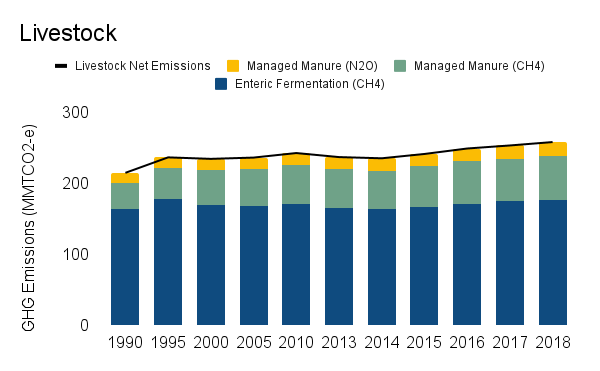
When we break down livestock emissions sources by animal, we see that in the United States cattle contribute the lion’s share of emissions, with beef cattle emitting significantly more overall than dairy cattle. The breakdown of emissions by animal varies. In beef cattle, almost all of the emissions come from enteric fermentation. In dairy cattle, it is closer to an even split between enteric CH4 and manure CH4, whereas in pigs and poultry most emissions come from manure.
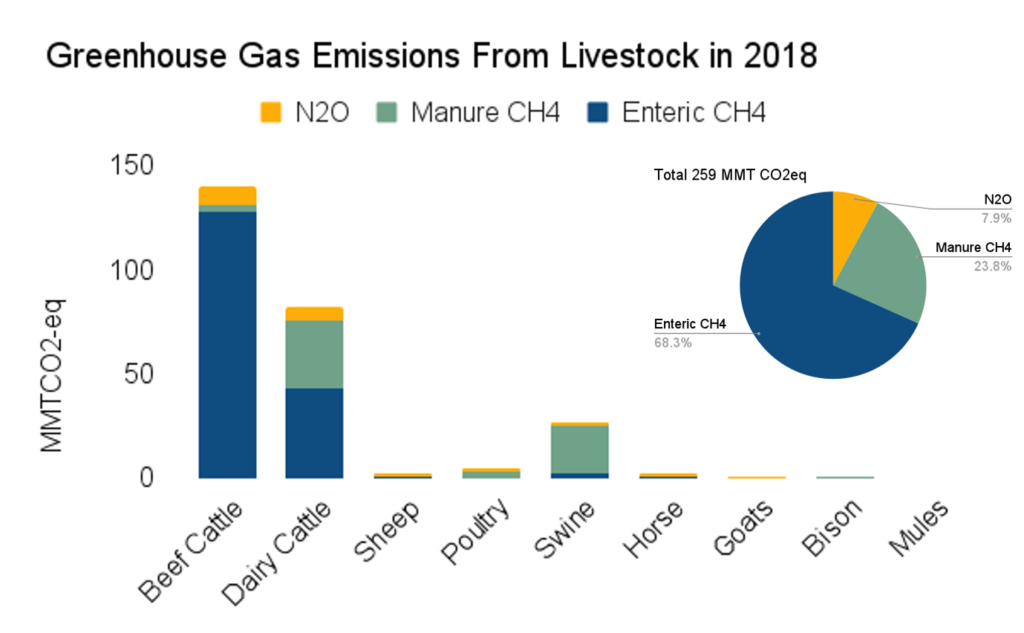
Enteric Fermentation
Within livestock raising, by far the largest source of emissions are methane emissions from enteric fermentation, which accounted for 51% of the total in 2018. The other emissions from the animals themselves are a combination of methane and nitrous oxide emissions from managed manure.
Enteric fermentation in ruminants is a digestive process where symbiotic microorganisms in the animal’s rumen (the first of its four stomach chambers) decompose and ferment carbohydrates, predominantly cellulose, under anaerobic conditions. This microbial fermentation produces methane as a byproduct, which is then expelled by the animal primarily through belching. The expelled methane is a form of energy loss for the ruminant animal.
Manure Management
Manure management for livestock involves the collection, storage, treatment, and utilization of animal feces and urine, which are byproducts of livestock production. Cow manure contains organic matter, and when it’s stored or managed, the decomposition of this organic material can release methane. When manure is stored in anaerobic conditions, such as in lagoons or pits, it provides an ideal environment for methanogenic microbes to convert the organic material into methane.When manure is applied to fields as fertilizer, the nitrogen content can undergo nitrification and denitrification processes, which can result in nitrous oxide emissions. Applied manure can also result in ammonia (NH3) emissions, which can react with other compounds to form fine particulate matter (PM2.5), which poses health and environmental concerns.
Emissions from Grazed Lands
Another significant source of livestock emissions is the grasslands that livestock such as cattle graze on. The vast majority of these emissions are in the form of nitrous oxide.
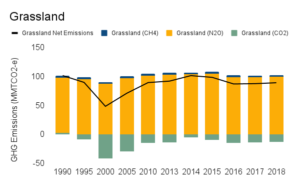
There is also a small amount of emissions from methane, related to livestock manure deposited in grazed lands, and some net sequestration of CO2. Whether the CO2 flux from grazed lands is net positive or negative depends in part on the prior land use of the grazed parcel. Pasture that was previously cropland tends to sequester CO2 for a period of time, whereas pasture that was previously forest tends to emit CO2. In either case, CO2 stores in grazed lands can be released if the land is deforested or stressors such as climate change change carbon cycle dynamics.
Cropland Emissions
The second-largest source of emissions in U.S. agriculture is crop production. Again, the USDA data is informative.
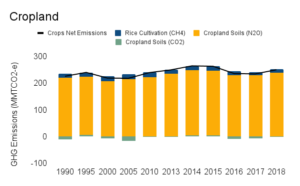
The vast majority of crop emissions come in the form of nitrous oxide. These result when nitrogen added to soils in the form of fertilizer or organic residues is converted into N2O by nitrification and denitrification. The intensity of these emissions can be increased by certain agricultural practices, such as over-fertilization, improper timing of fertilizer application, lack of crop rotation, and practices that limit oxygen through compaction or high water content.
The other significant, but much smaller, source of emissions is methane from rice cultivation. As discussed, microbes make methane in anaerobic conditions, such as those found in the waterlogged soils of rice paddies.
Finally, crop soils sequester a small amount of CO2 on net. Crop soils capture CO2 by photosynthesis, turning it into plant matter that adds to soil carbon when plants decay. This carbon is stabilized in the soil by organisms that incorporate it into humus and soil aggregates. However, soil carbon is released as CO2 when microbes decompose organic matter, especially when farming practices like tillage expose more soil to air.
Residue burning, our last category, contributes less than 1% of the total GHG emissions in the form of methane and nitrous oxide.
Other Emissions Sources
On-farm energy use is an important contributor to agricultural GHG emissions. In 2018, on-farm energy use was 11.6% of total agricultural emissions.
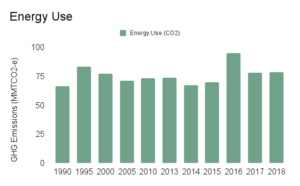
Looking Ahead: Solutions
In this first blog post of our 2-part series on decarbonizing agriculture in the United States, we have laid a foundation for the conversation by reviewing the various sources of agricultural emissions and the basic biogeochemical processes that shape them. In part 2 of the series, we will apply this understanding to review GHG mitigation strategies for each aspect of U.S. agriculture we discussed in part 1.
At Klimate Consulting, we understand the intricacies of decarbonizing agriculture and the broader implications for food systems. We provide research-based insights and strategic guidance to organizations aiming to navigate the complexities of sustainability. To learn more about how we can help you achieve your organizational goals, get in touch or book a free consultation with us.
Sources
Electronic Code of Federal Regulations. (n.d.). § 780.328 Practices performed by a farmer on farm commodities. e-CFR. Retrieved November 9, 2023, from https://www.ecfr.gov/current/title-29/subtitle-B/chapter-V/subchapter-B/part-780/subpart-D/subject-group-ECFR1b4fcdd2a835f12/section-780.328
United States Department of Agriculture. (2020). USDA Agriculture Greenhouse Gas Inventory: 1990-2018. Retrieved November 9, 2023, from https://www.usda.gov/sites/default/files/documents/USDA-GHG-Inventory-1990-2018.pdf
United States Environmental Protection Agency. (2020). Inventory of U.S. Greenhouse Gas Emissions and Sinks: 1990-2018. EPA. Retrieved November 9, 2023, from https://www.epa.gov/sites/default/files/2020-04/documents/us-ghg-inventory-1990-2018-data-highlights.pdf
Searchinger, T., Wirsenius, S., Beringer, T., & Dumas, P. (2021). Assessing the efficiency of changes in land use for mitigating climate change. Nature Food, 2(1), 32–40. https://doi.org/10.1038/s43016-021-00225-9